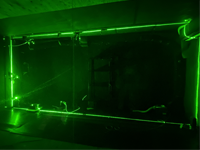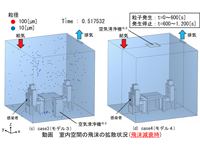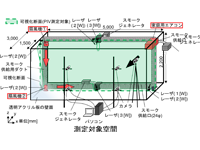AKABAYASHI / ARINAMI LAB
Reserchworks




| 1. Field Study of indoor air quality in residential house at Niigata prefecture. |
The investigationof indoor chemistry concentration and questionnaire survey of a consciousness
of occupants are conducted. The purpose of the investigation is to clarify the relationship between
life styles, air tightness and indoor air quality.
(1) About 60 percents of residentsat this time know a “sick house” and “chemical sensitivity”.
(2) When air tightness improves,indoor air formaldehyde concentration becomes high.
(3) When the age of house is old, indoorair formaldehyde concentration becomes low.
(4) Life style of residents hasalso high influence on indoor air pollution.
| 2. Study on highly efficient ventilation and air conditioning system by considering the distribution of fresh air. |
In an air conditioning office building, the ventilation air is normally mixed with return air from the room within an air
handling unit. In this system, the fresh air is distributed also into the non-breathing zone. If only the fresh air is
supplied into the breathing zone directory, the indoor air quality in the breathing zone will be improved and the
requirement of the fresh air can be reduced in comparison with conventional air conditioning systems.
The CFD simulation was carried out to compare the age of air and the concentration of contaminant between two
types of ventilation systems are analyzed.
| 3. The validation for the prediction accuracy of CFD technique for the flowfield around buildings. |
The wind tunnel experiment for two rectangular buildings model with the scale ratio of 2:1:1 in parallel arrangement with oblique wind angles was carried out. The experimental database was used for validation for the prediction accuracy of CFD technique applied for this flowfield. The special attention was paid to the velocity distribution in strong wind region near ground surface for the validation. The CFD analysis with two turbulence models, i.e. the standard k-e model, was conducted in order to clarify the prediction accuracy of CFD methods in comparison with the experimental database.
| 4. Researchon the validity of photovoltaic generation in Tohoku district |
The purpose of this research is to make the map of solar power generation of the whole country of Japan... Then in this research we calculate the effects on an economical and environmental evaluation when solar power generation was introduced in detached houses. To evaluate the system of solar power generation effectively, investigation of the energy consumption and of the measurement of electric energy consumption are carried out. The effects of solar power generation are examined by comparing it with the electric energy consumption that was consumed in detached houses. The effects on an economy and environmental evaluation are examined by introducing the detached houses in seven prefectures in Tohoku area of Japan. Finally the validity of the system of solar power generation is examined.
| 5.Detail survey of long term energy consumption and thermal environment for many houses in principal cities of Japan |
In order to obtain the fundamental information for discussing residential energy saving strategies, long term investigation of detail energy consumption and indoor climate have been done in 2002 to 2003 for 80dwellings, including detached houses and apartments, in six districts o Japan. The occupant’s behavior and building thermal performance were also investigated. Energy consumption for each appliance was measured as much as possible.
| 6. Study on the evaluation method of a cross ventilated building performance. |
In this study, we evaluate cross ventilation by the multi zone network air flow simulation and the CFD. Cross-
ventilated detached house is evaluated. Quantitative evaluation of the effect of cross ventilation is carried out. The
analytic object is a standard residence model. The k-e turbulence model simulated the air flow in and around the
building. The purpose of this simulation is to calculate indoor air flow velocity distribution.
The multi-zone airflow network model analysis using TRNSYS-COMIS simulate the indoor temperature. Two
different analyses are coupled, so that the long-term simulation is realized.
This study can report the evaluation index of natural cross ventilation performance.
| 7.Experimental and numerical study on kitchen ventilation. |
This study was conducted by experimental and numerical method to analyses the ventilation efficiency for commercial and house kitchen.
Architecture Program ,FACULTY OF ENGINEERING
NIIGATA UNIVERSITY
〒950-2181
8050,Ikarashi2nocho,nishi-ku Niigata
TEL.025-262-7209
FAX.025-262-7188
E-mail.arinamiy@eng.niigata-u.ac.jp